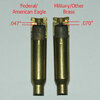CQB45ACP
Member
I have many countersinks of various sizes and used to use them to deburr flash holes. I could’ve but didn’t think to use one to remove a crimp. But, my complaint would be trying to ensure you’re holding it properly vertical so the beveling would work its magic and not get it all “catty wompus” as my dad used to say.Many manufacturers try to reach the lowest common denominator/customer. Many reloaders are not very mechanically inclined and not "handy" with tools (not a criticism). So reloading tool manufacturers advertise their tools to reach reloaders that are not familiar with the difference between a swage, ream or cutting tool, hence "primer pocket tool" can be one of several tools to do something to a primer pocket...
IIRC, I don't remember any RCBS, Lyman have any primer pocket tools resembling a countersink, and Lee makes something that looks close but in shape only...
I am not trying to be a "vocabulary Nazi" and you can call magazines clips or cartridges bullets, but just trying to make myself clear. I cut primer crimps out with a plain old, everyday countersink...
So, all that’s to say, I like the “pocket tools” mentioned above and have the Lyman. It’s reamer bit makes far far easier work of keeping the correct angle.







